

Compact Muon Solenoid
LHC, CERN
| CMS-PAS-SUS-21-002 | ||
| Search for electroweak production of supersymmetric particles in final states containing hadronic decays of WW, WZ, or WH and missing transverse momentum | ||
| CMS Collaboration | ||
| August 2021 | ||
| Abstract: Results are presented from a search for chargino-neutralino or chargino pair production via electroweak interactions. The results are based on a sample of √s= 13 TeV proton-proton collisions from the LHC, recorded with the CMS detector and corresponding to an integrated luminosity of 137 fb−1. The search considers final states with large missing transverse momentum and pairs of hadronically decaying bosons WW, WZ, and WH, which are identified using novel algorithms. No significant excess of events is observed relative to the expectation from the standard model. Limits at the 95% confidence level are placed on the cross section for production of mass-degenerate wino-like superpartners of SU(2) gauge bosons, ˜χ±1/˜χ02. In the limit of nearly-massless neutralinos ˜χ01, ˜χ±1/˜χ02 with masses up to 870 and 960 GeV are excluded in the cases of ˜χ02→Z˜χ01 and ˜χ02→H˜χ01, respectively. Interpretations for other models are also presented. | ||
|
Links:
CDS record (PDF) ;
CADI line (restricted) ;
These preliminary results are superseded in this paper, Submitted to PLB. |
||
| Figures | |

png pdf |
Figure 1:
Production of ˜χ±1˜χ02 and ˜χ±1˜χ∓1 with the ˜χ±1 decaying to a W boson and ˜χ01 and the ˜χ02 decaying to either a Z boson or a Higgs boson and ˜χ01. |

png pdf |
Figure 1-a:
Production of ˜χ±1˜χ02 and ˜χ±1˜χ∓1 with the ˜χ±1 decaying to a W boson and ˜χ01 and the ˜χ02 decaying to either a Z boson or a Higgs boson and ˜χ01. |
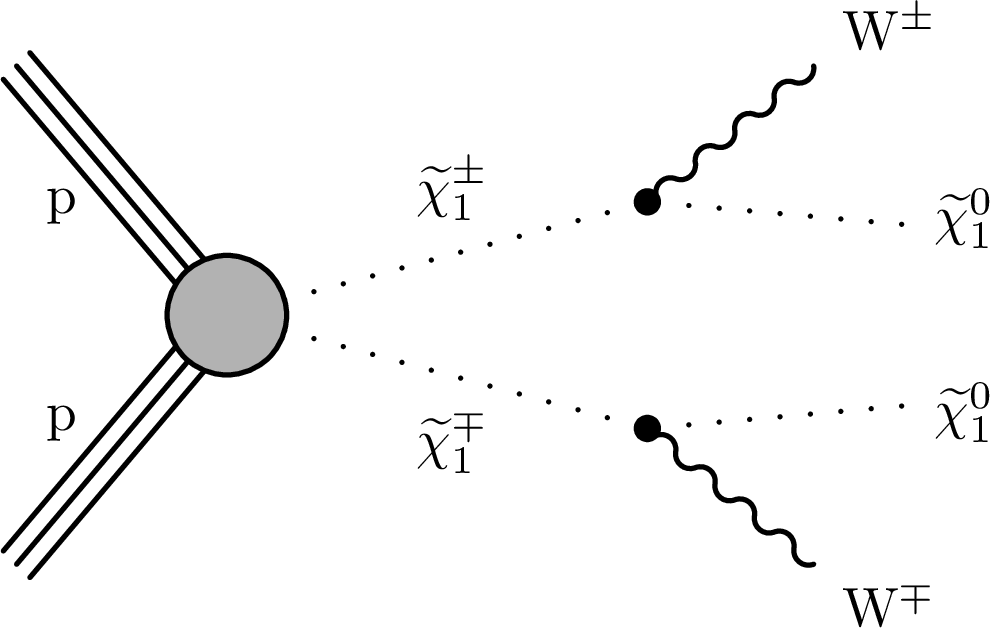
png pdf |
Figure 1-b:
Production of ˜χ±1˜χ02 and ˜χ±1˜χ∓1 with the ˜χ±1 decaying to a W boson and ˜χ01 and the ˜χ02 decaying to either a Z boson or a Higgs boson and ˜χ01. |

png pdf |
Figure 2:
Distributions of the jet mass for V-tagged AK8 jets in the b-veto SR (left) and bˉb-tagged AK8 jets in the WH SR (right). The jet mass requirements for the V and bˉb taggers have been loosened in these figures. The filled histograms show the SM background predictions. The open histograms show the SM background predictions plus the expectations for selected signal models, which are denoted in the legend by the name of the model followed by the assumed masses of the NLSP and LSP. The observed event yields are indicated by black markers. |
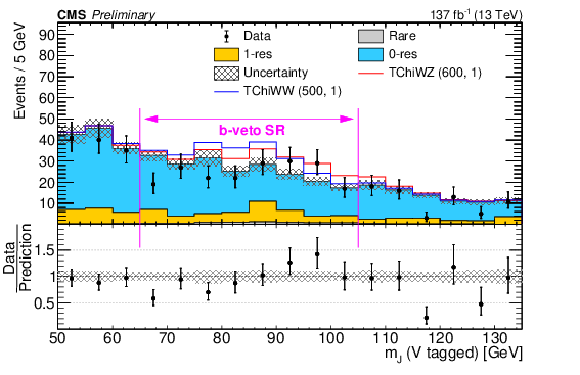
png pdf |
Figure 2-a:
Distributions of the jet mass for V-tagged AK8 jets in the b-veto SR (left) and bˉb-tagged AK8 jets in the WH SR (right). The jet mass requirements for the V and bˉb taggers have been loosened in these figures. The filled histograms show the SM background predictions. The open histograms show the SM background predictions plus the expectations for selected signal models, which are denoted in the legend by the name of the model followed by the assumed masses of the NLSP and LSP. The observed event yields are indicated by black markers. |

png pdf |
Figure 2-b:
Distributions of the jet mass for V-tagged AK8 jets in the b-veto SR (left) and bˉb-tagged AK8 jets in the WH SR (right). The jet mass requirements for the V and bˉb taggers have been loosened in these figures. The filled histograms show the SM background predictions. The open histograms show the SM background predictions plus the expectations for selected signal models, which are denoted in the legend by the name of the model followed by the assumed masses of the NLSP and LSP. The observed event yields are indicated by black markers. |
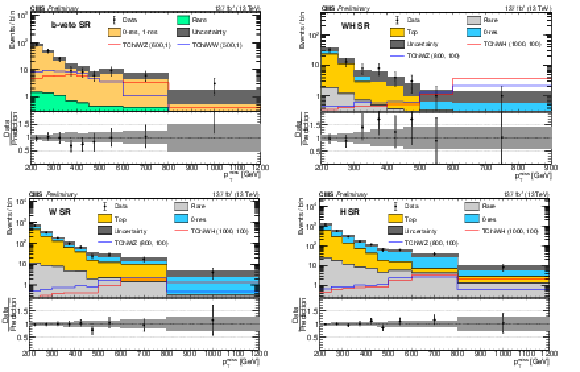
png pdf |
Figure 3:
Prediction vs. data in the b-veto SR (upper left), the WH SR (upper right), the W SR (lower left), and the H SR (lower right). The filled histograms show the SM background predictions, and the open histograms show the expectations for selected signal models, which are denoted in the legend by the name of the model followed by the assumed masses of the NLSP and LSP. The observed event yields are indicated by black markers. |

png pdf |
Figure 3-a:
Prediction vs. data in the b-veto SR (upper left), the WH SR (upper right), the W SR (lower left), and the H SR (lower right). The filled histograms show the SM background predictions, and the open histograms show the expectations for selected signal models, which are denoted in the legend by the name of the model followed by the assumed masses of the NLSP and LSP. The observed event yields are indicated by black markers. |

png pdf |
Figure 3-b:
Prediction vs. data in the b-veto SR (upper left), the WH SR (upper right), the W SR (lower left), and the H SR (lower right). The filled histograms show the SM background predictions, and the open histograms show the expectations for selected signal models, which are denoted in the legend by the name of the model followed by the assumed masses of the NLSP and LSP. The observed event yields are indicated by black markers. |

png pdf |
Figure 3-c:
Prediction vs. data in the b-veto SR (upper left), the WH SR (upper right), the W SR (lower left), and the H SR (lower right). The filled histograms show the SM background predictions, and the open histograms show the expectations for selected signal models, which are denoted in the legend by the name of the model followed by the assumed masses of the NLSP and LSP. The observed event yields are indicated by black markers. |

png pdf |
Figure 3-d:
Prediction vs. data in the b-veto SR (upper left), the WH SR (upper right), the W SR (lower left), and the H SR (lower right). The filled histograms show the SM background predictions, and the open histograms show the expectations for selected signal models, which are denoted in the legend by the name of the model followed by the assumed masses of the NLSP and LSP. The observed event yields are indicated by black markers. |

png pdf |
Figure 4:
Expected and observed 95% CL upper limits on the production cross section for ˜χ±1˜χ∓1 production assuming they each decay to a W boson (upper left) and ˜χ±1˜χ02 production assuming they decay to a W boson and a Z boson (upper right) or to a W boson and a H boson (lower left and lower right). In the upper plots and the lower left plot, the red (black) contours represent the expected (observed) mass exclusion limits. Mass exclusion limits are computed assuming wino-like cross sections. In the lower right plot the ˜χ01 mass is assumed to be 1 GeV and the red and blue curves correspond to wino-like and higgsino-like production cross sections, respectively. For the higgsino cross section curve, ˜χ±1, ˜χ02, and ˜χ03 are considered mass degenerate with an effective cross section equal to the sum of the ˜χ±1˜χ02 and ˜χ±1˜χ03 cross sections. |
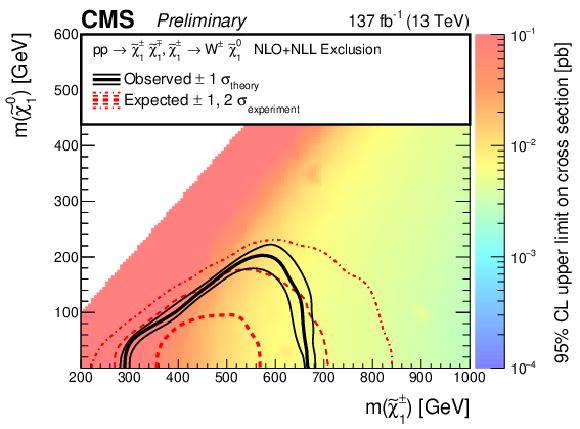
png pdf |
Figure 4-a:
Expected and observed 95% CL upper limits on the production cross section for ˜χ±1˜χ∓1 production assuming they each decay to a W boson (upper left) and ˜χ±1˜χ02 production assuming they decay to a W boson and a Z boson (upper right) or to a W boson and a H boson (lower left and lower right). In the upper plots and the lower left plot, the red (black) contours represent the expected (observed) mass exclusion limits. Mass exclusion limits are computed assuming wino-like cross sections. In the lower right plot the ˜χ01 mass is assumed to be 1 GeV and the red and blue curves correspond to wino-like and higgsino-like production cross sections, respectively. For the higgsino cross section curve, ˜χ±1, ˜χ02, and ˜χ03 are considered mass degenerate with an effective cross section equal to the sum of the ˜χ±1˜χ02 and ˜χ±1˜χ03 cross sections. |

png pdf |
Figure 4-b:
Expected and observed 95% CL upper limits on the production cross section for ˜χ±1˜χ∓1 production assuming they each decay to a W boson (upper left) and ˜χ±1˜χ02 production assuming they decay to a W boson and a Z boson (upper right) or to a W boson and a H boson (lower left and lower right). In the upper plots and the lower left plot, the red (black) contours represent the expected (observed) mass exclusion limits. Mass exclusion limits are computed assuming wino-like cross sections. In the lower right plot the ˜χ01 mass is assumed to be 1 GeV and the red and blue curves correspond to wino-like and higgsino-like production cross sections, respectively. For the higgsino cross section curve, ˜χ±1, ˜χ02, and ˜χ03 are considered mass degenerate with an effective cross section equal to the sum of the ˜χ±1˜χ02 and ˜χ±1˜χ03 cross sections. |
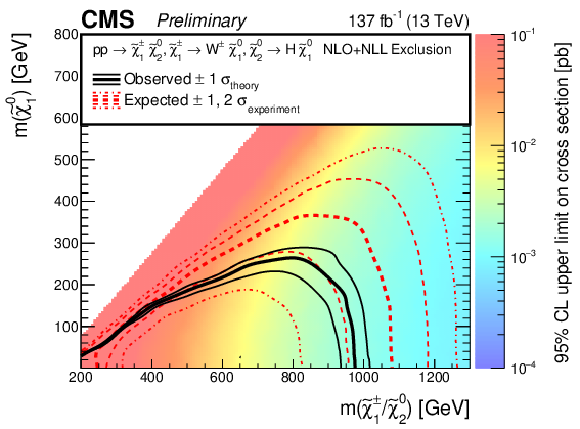
png pdf |
Figure 4-c:
Expected and observed 95% CL upper limits on the production cross section for ˜χ±1˜χ∓1 production assuming they each decay to a W boson (upper left) and ˜χ±1˜χ02 production assuming they decay to a W boson and a Z boson (upper right) or to a W boson and a H boson (lower left and lower right). In the upper plots and the lower left plot, the red (black) contours represent the expected (observed) mass exclusion limits. Mass exclusion limits are computed assuming wino-like cross sections. In the lower right plot the ˜χ01 mass is assumed to be 1 GeV and the red and blue curves correspond to wino-like and higgsino-like production cross sections, respectively. For the higgsino cross section curve, ˜χ±1, ˜χ02, and ˜χ03 are considered mass degenerate with an effective cross section equal to the sum of the ˜χ±1˜χ02 and ˜χ±1˜χ03 cross sections. |
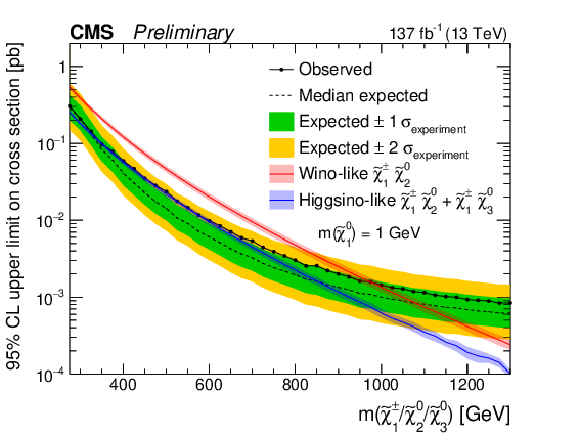
png pdf |
Figure 4-d:
Expected and observed 95% CL upper limits on the production cross section for ˜χ±1˜χ∓1 production assuming they each decay to a W boson (upper left) and ˜χ±1˜χ02 production assuming they decay to a W boson and a Z boson (upper right) or to a W boson and a H boson (lower left and lower right). In the upper plots and the lower left plot, the red (black) contours represent the expected (observed) mass exclusion limits. Mass exclusion limits are computed assuming wino-like cross sections. In the lower right plot the ˜χ01 mass is assumed to be 1 GeV and the red and blue curves correspond to wino-like and higgsino-like production cross sections, respectively. For the higgsino cross section curve, ˜χ±1, ˜χ02, and ˜χ03 are considered mass degenerate with an effective cross section equal to the sum of the ˜χ±1˜χ02 and ˜χ±1˜χ03 cross sections. |

png pdf |
Figure 5:
Expected and observed 95% CL exclusion for mass-degenerate wino-like ˜χ±1˜χ∓1 and ˜χ±1˜χ02 production as a function of NLSP and LSP masses. |
| Tables | |
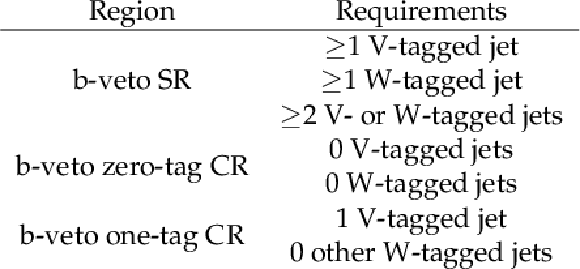
png pdf |
Table 1:
Summary of tagging requirements for the b-veto SR and CRs. Each of these regions includes the baseline requirements described in Section xxxxx, as well as requiring zero b-tagged AK4 jets and requiring at least two AK8 jets satisfying 65 <mJ< 105 GeV. The SR and CRs are described in detail in Sections uuuuu and vvvvv, respectively. The W and V taggers are described in Section ttttt. |

png pdf |
Table 2:
Summary of tagging requirements for the b-tag SRs and CRs. Each of these regions includes the baseline requirements described in Section xxxxx, as well as requiring at least one b-tagged AK4 jet and at least two AK8 jets. The SRs and CRs are described in detail in Sections yyyyy and zzzzz, respectively. The bˉb and W taggers are described in Section ttttt, and the definitions of W and Higgs boson candidates are given in Section yyyyy. In addition to the six regions described in this table, the b-tag predictions also use six single-lepton CRs that are identical except that exactly one charged lepton is required. A dash (--) indicates that no requirement is imposed. |

png pdf |
Table 3:
Summary of the dominant systematic uncertainties (in %) in various analysis regions. For the 0- and 1-res backgrounds in the b-veto SR, uncertainties are presented separately depending on the CR region used for the estimation. A dash (--) indicates that the source of uncertainty is not applicable. |
| Summary |
|
A search is presented for signatures of electroweak production of supersymmetry in which a pair of charginos (˜χ±1 pair) or a chargino and a neutralino (˜χ±1˜χ02) are produced. The chargino ˜χ±1 is assumed to decay to the W boson and the lightest neutralino ˜χ01, and the neutralino ˜χ02 is assumed to decay to either the Z or Higgs boson and ˜χ01. The decay products of W, Z, or Higgs bosons are clustered into large-radius jets. These jets are categorized based on their mass and a collection of novel jet-tagging algorithms based on deep neural networks. Four signal regions are constructed to look for ˜χ±1 pair or ˜χ±1˜χ02 production signals with a pair of W bosons, a pair of W and Z bosons, or a pair of W and Higgs bosons, together with a large transverse momentum imbalance in the final state. In these simplified models, the charginos ˜χ±1 and the next-to-lightest neutralino ˜χ02 are assumed to be mass-degenerate next-to-lightest supersymmetric particles (NLSP), and the lightest neutralino ˜χ01 is assumed to be bino-like and to be the lightest supersymmetric particle (LSP). No statistically significant excess of events is observed in the data with respect to the expectation from the standard model. Using wino-like pair production cross sections, 95% confidence level (CL) mass exclusions are derived. For signals with WW, WZ, or WH final states, the NLSP mass exclusion limit for low-mass LSPs extends up to 670, 760, and 970 GeV, respectively. When we consider models including both wino-like NLSP ˜χ±1˜χ02 and ˜χ±1 pair production with either ˜χ02→Z˜χ01 or ˜χ02→H˜χ01, the NLSP mass exclusion extends up to 870 and 960 GeV, respectively. These mass exclusions are the most stringent constraints to date set by CMS at high NLSP masses. Results are also shown using the higgsino-like chargino-neutralino pair production cross section for signal events with a WH pair in the final state. NLSP masses between 325 and 850 GeV are expected to be excluded at 95% CL under the standard model hypothesis; however, the observed cross section upper limits lie mostly below the theoretical cross section because of a modest excess in data. |
| References | ||||
| 1 | P. Ramond | Dual theory for free fermions | PRD 3 (1971) 2415 | |
| 2 | Y. A. Golfand and E. P. Likhtman | Extension of the algebra of Poincar\'e group generators and violation of P invariance | JEPTL 13 (1971)323 | |
| 3 | A. Neveu and J. H. Schwarz | Factorizable dual model of pions | NPB 31 (1971) 86 | |
| 4 | D. V. Volkov and V. P. Akulov | Possible universal neutrino interaction | JEPTL 16 (1972)438 | |
| 5 | J. Wess and B. Zumino | A Lagrangian model invariant under supergauge transformations | PLB 49 (1974) 52 | |
| 6 | J. Wess and B. Zumino | Supergauge transformations in four dimensions | NPB 70 (1974) 39 | |
| 7 | P. Fayet | Supergauge invariant extension of the Higgs mechanism and a model for the electron and its neutrino | NPB 90 (1975) 104 | |
| 8 | P. Fayet and S. Ferrara | Supersymmetry | PR 32 (1977) 249 | |
| 9 | H. P. Nilles | Supersymmetry, supergravity and particle physics | Phys. Rep. 110 (1984) 1 | |
| 10 | S. P. Martin | A supersymmetry primer | Adv. Ser. Direct. High Energy Phys. 21 (2010) 1 | hep-ph/9709356 |
| 11 | H. Baer et al. | Natural SUSY with a bino- or wino-like LSP | PRD 91 (2015) 075005 | 1501.06357 |
| 12 | H. Baer, V. Barger, N. Nagata, and M. Savoy | Phenomenological profile of top squarks from natural supersymmetry at the LHC | PRD 95 (2017) 055012 | 1611.08511 |
| 13 | ATLAS Collaboration | Search for bottom-squark pair production with the ATLAS detector in final states containing Higgs bosons, b-jets and missing transverse momentum | JHEP 12 (2019) 060 | 1908.03122 |
| 14 | ATLAS Collaboration | Search for a scalar partner of the top quark in the all-hadronic tˉt plus missing transverse momentum final state at √s= 13 TeV with the ATLAS detector | EPJC 80 (2020) 737 | 2004.14060 |
| 15 | ATLAS Collaboration | Search for squarks and gluinos in final states with jets and missing transverse momentum using 139 fb−1 of √s=13TeVpp collision data with the ATLAS detector | JHEP 02 (2021) 143 | 2010.14293 |
| 16 | ATLAS Collaboration | Search for new phenomena with top quark pairs in final states with one lepton, jets, and missing transverse momentum in pp collisions at √s= 13 TeV with the ATLAS detector | JHEP 04 (2021) 174 | 2012.03799 |
| 17 | ATLAS Collaboration | Search for squarks and gluinos in final states with one isolated lepton, jets, and missing transverse momentum at √s= 13 TeV with the ATLAS detector | EPJC 81 (2021) 600 | 2101.01629 |
| 18 | ATLAS Collaboration | Search for new phenomena in final states with b-jets and missing transverse momentum in √s=13TeVpp collisions with the ATLAS detector | JHEP 05 (2021) 093 | 2101.12527 |
| 19 | ATLAS Collaboration | Search for new phenomena in events with two opposite-charge leptons, jets and missing transverse momentum in pp collisions at √s= 13 TeV with the ATLAS detector | JHEP 04 (2021) 165 | 2102.01444 |
| 20 | ATLAS Collaboration | Search for bottom-squark pair production in pp collision events at √s= 13 TeV with hadronically decaying τ-leptons, b-jets and missing transverse momentum using the ATLAS detector | (3, 2021). Submitted to PRD | 2103.08189 |
| 21 | CMS Collaboration | Search for supersymmetry in proton-proton collisions at 13 TeV in final states with jets and missing transverse momentum | JHEP 10 (2019) 244 | CMS-SUS-19-006 1908.04722 |
| 22 | CMS Collaboration | Searches for physics beyond the standard model with the mT2 variable in hadronic final states with and without disappearing tracks in proton-proton collisions at √s= 13 TeV | EPJC 80 (2020) 3 | CMS-SUS-19-005 1909.03460 |
| 23 | CMS Collaboration | Search for supersymmetry in pp collisions at √s= 13 TeV with 137 fb−1 in final states with a single lepton using the sum of masses of large-radius jets | PRD 101 (2020) 052010 | CMS-SUS-19-007 1911.07558 |
| 24 | CMS Collaboration | Search for direct top squark pair production in events with one lepton, jets, and missing transverse momentum at 13 TeV with the CMS experiment | JHEP 05 (2020) 032 | CMS-SUS-19-009 1912.08887 |
| 25 | CMS Collaboration | Search for top squark pair production using dilepton final states in pp collision data collected at √s= 13 TeV | EPJC 81 (2021) 3 | CMS-SUS-19-011 2008.05936 |
| 26 | CMS Collaboration | Search for top squark production in fully-hadronic final states in proton-proton collisions at √s= 13 TeV | (3, 2021). Accepted by PRD | CMS-SUS-19-010 2103.01290 |
| 27 | CMS Collaboration | Combined searches for the production of supersymmetric top quark partners in proton-proton collisions at √s= 13 TeV | (7, 2021). Submitted to EPJC | CMS-SUS-20-002 2107.10892 |
| 28 | N. Arkani-Hamed et al. | MARMOSET: the path from LHC data to the new standard model via on-shell effective theories | hep-ph/0703088 | |
| 29 | J. Alwall, P. Schuster, and N. Toro | Simplified models for a first characterization of new physics at the LHC | PRD 79 (2009) 075020 | 0810.3921 |
| 30 | J. Alwall, M.-P. Le, M. Lisanti, and J. G. Wacker | Model-independent jets plus missing energy searches | PRD 79 (2009) 015005 | 0809.3264 |
| 31 | D. Alves et al. | Simplified models for LHC new physics searches | JPG 39 (2012) 105005 | 1105.2838 |
| 32 | CMS Collaboration | Interpretation of searches for supersymmetry with simplified models | PRD 88 (2013) 052017 | CMS-SUS-11-016 1301.2175 |
| 33 | G. R. Farrar and P. Fayet | Phenomenology of the production, decay, and detection of new hadronic states associated with supersymmetry | PLB 76 (1978) 575 | |
| 34 | ATLAS Collaboration | Search for electroweak production of supersymmetric particles in final states with two or three leptons at √s= 13 TeV with the ATLAS detector | EPJC 78 (2018) 995 | 1803.02762 |
| 35 | ATLAS Collaboration | Search for chargino-neutralino production using recursive jigsaw reconstruction in final states with two or three charged leptons in proton-proton collisions at √s= 13 TeV with the ATLAS detector | PRD 98 (2018) 092012 | 1806.02293 |
| 36 | ATLAS Collaboration | Search for chargino and neutralino production in final states with a Higgs boson and missing transverse momentum at √s= 13 TeV with the ATLAS detector | PRD 100 (2019) 012006 | 1812.09432 |
| 37 | ATLAS Collaboration | Search for electroweak production of charginos and sleptons decaying into final states with two leptons and missing transverse momentum in √s=13TeVpp collisions using the ATLAS detector | EPJC 80 (2020) 123 | 1908.08215 |
| 38 | ATLAS Collaboration | Search for direct production of electroweakinos in final states with one lepton, missing transverse momentum and a Higgs boson decaying into two b-jets in pp collisions at √s= 13 TeV with the ATLAS detector | EPJC 80 (2020) 691 | 1909.09226 |
| 39 | ATLAS Collaboration | Search for chargino-neutralino production with mass splittings near the electroweak scale in three-lepton final states in √s=13TeVpp collisions with the ATLAS detector | PRD 101 (2020) 072001 | 1912.08479 |
| 40 | ATLAS Collaboration | Search for chargino-neutralino pair production in final states with three leptons and missing transverse momentum in √s=13TeVpp collisions with the ATLAS detector | (6, 2021). Submitted to EPJC | 2106.01676 |
| 41 | ATLAS Collaboration | Search for charginos and neutralinos in final states with two boosted hadronically decaying bosons and missing transverse momentum in pp collisions at √s= 13 TeV with the ATLAS detector | (8, 2021). Submitted to PRD | 2108.07586 |
| 42 | CMS Collaboration | Search for electroweak production of charginos and neutralinos in WH events in proton-proton collisions at √s= 13 TeV | JHEP 11 (2017) 029 | CMS-SUS-16-043 1706.09933 |
| 43 | CMS Collaboration | Search for electroweak production of charginos and neutralinos in multilepton final states in proton-proton collisions at √s= 13 TeV | JHEP 03 (2018) 166 | CMS-SUS-16-039 1709.05406 |
| 44 | CMS Collaboration | Combined search for electroweak production of charginos and neutralinos in proton-proton collisions at √s= 13 TeV | JHEP 03 (2018) 160 | CMS-SUS-17-004 1801.03957 |
| 45 | CMS Collaboration | Searches for pair production of charginos and top squarks in final states with two oppositely charged leptons in proton-proton collisions at √s= 13 TeV | JHEP 11 (2018) 079 | CMS-SUS-17-010 1807.07799 |
| 46 | CMS Collaboration | Search for supersymmetry in final states with two oppositely charged same-flavor leptons and missing transverse momentum in proton-proton collisions at √s= 13 TeV | JHEP 04 (2021) 123 | CMS-SUS-20-001 2012.08600 |
| 47 | CMS Collaboration | Search for electroweak production of charginos and neutralinos in proton-proton collisions at √s= 13 TeV | (6, 2021). Submitted to JHEP | CMS-SUS-19-012 2106.14246 |
| 48 | CMS Collaboration | Search for chargino-neutralino production in events with Higgs and W bosons using 137 fb−1 of proton-proton collisions at √s= 13 TeV | (7, 2021). Submitted to JHEP | CMS-SUS-20-003 2107.12553 |
| 49 | CMS Collaboration | Identification of heavy, energetic, hadronically decaying particles using machine-learning techniques | JINST 15 (2020) P06005 | CMS-JME-18-002 2004.08262 |
| 50 | J. Alwall et al. | The automated computation of tree-level and next-to-leading order differential cross sections, and their matching to parton shower simulations | JHEP 07 (2014) 079 | 1405.0301 |
| 51 | P. Nason | A new method for combining NLO QCD with shower Monte Carlo algorithms | JHEP 11 (2004) 040 | hep-ph/0409146 |
| 52 | S. Frixione, P. Nason, and C. Oleari | Matching NLO QCD computations with parton shower simulations: the POWHEG method | JHEP 11 (2007) 070 | 0709.2092 |
| 53 | S. Alioli, P. Nason, C. Oleari, and E. Re | A general framework for implementing NLO calculations in shower Monte Carlo programs: the POWHEG BOX | JHEP 06 (2010) 043 | 1002.2581 |
| 54 | S. Alioli, P. Nason, C. Oleari, and E. Re | NLO single-top production matched with shower in POWHEG: s- and t-channel contributions | JHEP 09 (2009) 111 | 0907.4076 |
| 55 | E. Re | Single-top Wt-channel production matched with parton showers using the POWHEG method | EPJC 71 (2011) 1547 | 1009.2450 |
| 56 | T. Melia, P. Nason, R. Rontsch, and G. Zanderighi | W+W−, WZ and ZZ production in the POWHEG BOX | JHEP 11 (2011) 078 | 1107.5051 |
| 57 | P. Nason and G. Zanderighi | W+W−, WZ and ZZ production in the POWHEG-BOX-V2 | EPJC 74 (2014) 2702 | 1311.1365 |
| 58 | H. B. Hartanto, B. Jager, L. Reina, and D. Wackeroth | Higgs boson production in association with top quarks in the POWHEG BOX | PRD 91 (2015) 094003 | 1501.04498 |
| 59 | NNPDF Collaboration | Parton distributions for the LHC run II | JHEP 04 (2015) 040 | 1410.8849 |
| 60 | NNPDF Collaboration | Parton distributions from high-precision collider data | EPJC 77 (2017) 663 | 1706.00428 |
| 61 | T. Sjostrand et al. | An Introduction to PYTHIA 8.2 | CPC 191 (2015) 159 | 1410.3012 |
| 62 | CMS Collaboration | Event generator tunes obtained from underlying event and multiparton scattering measurements | EPJC 76 (2016) 155 | CMS-GEN-14-001 1512.00815 |
| 63 | CMS Collaboration | Extraction and validation of a new set of CMS PYTHIA8 tunes from underlying-event measurements | EPJC 80 (2020) 4 | CMS-GEN-17-001 1903.12179 |
| 64 | GEANT4 Collaboration | GEANT4 --- a simulation toolkit | NIMA 506 (2003) 250 | |
| 65 | S. Abdullin et al. | The fast simulation of the CMS detector at LHC | J. Phys. Conf. Ser. 331 (2011) 032049 | |
| 66 | A. Giammanco | The fast simulation of the CMS experiment | J. Phys. Conf. Ser. 513 (2014) 022012 | |
| 67 | B. Fuks, M. Klasen, D. R. Lamprea, and M. Rothering | Gaugino production in proton-proton collisions at a center-of-mass energy of 8 TeV | JHEP 10 (2012) 081 | 1207.2159 |
| 68 | B. Fuks, M. Klasen, D. R. Lamprea, and M. Rothering | Precision predictions for electroweak superpartner production at hadron colliders with resummino | EPJC 73 (2013) 2480 | 1304.0790 |
| 69 | CMS Collaboration | The CMS experiment at the CERN LHC | JINST 3 (2008) S08004 | CMS-00-001 |
| 70 | M. Cacciari, G. P. Salam, and G. Soyez | The anti-kT jet clustering algorithm | JHEP 04 (2008) 063 | 0802.1189 |
| 71 | M. Cacciari, G. P. Salam, and G. Soyez | FastJet user manual | EPJC 72 (2012) 1896 | 1111.6097 |
| 72 | CMS Collaboration | Particle-flow reconstruction and global event description with the CMS detector | JINST 12 (2017) P10003 | CMS-PRF-14-001 1706.04965 |
| 73 | CMS Collaboration | Pileup mitigation at CMS in 13 TeV data | JINST 15 (2020) P09018 | CMS-JME-18-001 2003.00503 |
| 74 | D. Bertolini, P. Harris, M. Low, and N. Tran | Pileup Per Particle Identification | JHEP 10 (2014) 059 | 1407.6013 |
| 75 | CMS Collaboration | Jet energy scale and resolution in the CMS experiment in pp collisions at 8 TeV | JINST 12 (2017) P02014 | CMS-JME-13-004 1607.03663 |
| 76 | A. J. Larkoski, S. Marzani, G. Soyez, and J. Thaler | Soft drop | JHEP 05 (2014) 146 | 1402.2657 |
| 77 | CMS Collaboration | Performance of missing transverse momentum reconstruction in proton-proton collisions at √s= 13 TeV using the CMS detector | JINST 14 (2019) P07004 | CMS-JME-17-001 1903.06078 |
| 78 | CMS Collaboration | Identification of heavy-flavour jets with the CMS detector in pp collisions at 13 TeV | JINST 13 (2018) P05011 | CMS-BTV-16-002 1712.07158 |
| 79 | CMS Collaboration | Search for supersymmetry in pp collisions at √s= 13 TeV in the single-lepton final state using the sum of masses of large-radius jets | JHEP 08 (2016) 122 | CMS-SUS-15-007 1605.04608 |
| 80 | K. Rehermann and B. Tweedie | Efficient identification of boosted semileptonic top quarks at the LHC | JHEP 03 (2011) 059 | 1007.2221 |
| 81 | CMS Collaboration | Performance of photon reconstruction and identification with the CMS detector in proton-proton collisions at √s= 8 TeV | JINST 10 (2015) P08010 | CMS-EGM-14-001 1502.02702 |
| 82 | G. Louppe, M. Kagan, and K. Cranmer | Learning to pivot with adversarial networks | in Advances in Neural Information Processing Systems, volume 30, p. 981 2017 | 1611.01046 |
| 83 | CMS Collaboration | The CMS trigger system | JINST 12 (2017) P01020 | CMS-TRG-12-001 1609.02366 |
| 84 | CMS Collaboration | Performance of the CMS muon detector and muon reconstruction with proton-proton collisions at √s= 13 TeV | JINST 13 (2018) P06015 | CMS-MUO-16-001 1804.04528 |
| 85 | CMS Collaboration | Performance of electron reconstruction and selection with the CMS detector in proton-proton collisions at $√s= $ 8 TeV | JINST 10 (2015) P06005 | CMS-EGM-13-001 1502.02701 |
| 86 | R. J. Barlow and C. Beeston | Fitting using finite Monte Carlo samples | CPC 77 (1993) 219 | |
| 87 | A. L. Read | Presentation of search results: The CLs technique | JPG 28 (2002) 2693 | |
| 88 | T. Junk | Confidence level computation for combining searches with small statistics | NIMA 434 (1999) 435 | hep-ex/9902006 |
| 89 | G. Cowan, K. Cranmer, E. Gross, and O. Vitells | Asymptotic formulae for likelihood-based tests of new physics | EPJC 71 (2011) 1554 | 1007.1727 |

|
Compact Muon Solenoid LHC, CERN |

|

|

|

|

|

|